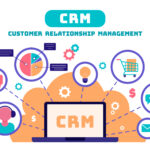Any firm that wants to turn potential consumers into long-term customers has to know how to manage leads well. Having a disciplined way to manage leads will help your business develop and do well, whether you run a small startup or a big company. A good lead management system doesn’t only collect leads; it also nurtures them throughout the sales cycle to give you the best opportunity of converting them. This article will talk about what lead management is, why it’s important, and how to do it well.
What does lead management mean?
Lead management is the organized way of getting, keeping track of, nurturing, and turning potential leads into real customers. It’s an important part of any business’s plan for sales and marketing. Lead management is the process of putting leads into different phases, keeping in touch with them all the time, and making sure that every opportunity is used to its fullest. The main purpose of lead management is to make sure that no lead is lost and that every engagement with a prospect is useful.
There are usually four basic parts to the process:
- Lead Capture: Getting the contact information of people who could be interested in your business.
- Lead Scoring: Putting leads in order of how likely they are to become customers.
- Lead Nurturing: Getting to know your prospects and helping them go through the sales funnel.
- Lead conversion is the process of turning potential customers into paying customers.
- Managing leads well means more than just gathering information. It means making every interaction with a potential customer meaningful. The end goal is to make the process smoother so that your sales staff can work more efficiently and get the most sales.
What Makes Lead Management Important?
Lead management is very important. Businesses could lose out on good leads to competitors or let good leads slip through the cracks if they don’t have a good strategy for handling leads. Some of the most important benefits of having a strong lead management strategy are listed below:
More efficient sales
A well-organized lead management strategy lets sales teams spend more time on important tasks instead of doing paperwork. Sales teams can focus on closing deals instead of looking for leads or manually handling massive amounts of data by automating lead monitoring and using technologies like CRMs (Customer Relationship Management systems).
Better Lead Care
Businesses can take care of their leads well if they have a defined system. Lead nurturing keeps prospects in touch with you so they stay interested and keep moving through the sales funnel. This lowers the chance that leads may get stuck and be lost to competitors.
Better relationships with customers
A disciplined way to manage leads lets you develop solid relationships with prospects by giving them value at every step of the way. This kind of targeted communication and valuable information helps create relationships, which makes it more likely that prospects will become long-term customers.
Better decisions based on data
By using a lead management system, you may gather useful information about how leads act and communicate with you. Businesses may improve their plans and make smart choices based on real results instead of guesses by looking at this data.
Important Steps in Managing Leads
To make an efficient sales plan, you need to know the steps of lead management. The following are the most important steps in managing leads:
1. Getting Leads
The first step is to get leads. It means getting useful information from possible clients so that leads can be developed. People frequently get this information through things like online forms, social media campaigns, email sign-ups, and live chat.
How to Get Leads in the Right Way:
- Use rewards: If you provide users something of value, like free trials, eBooks, or discounts, they may be more likely to give you their contact information.
- Make your website better: Make sure it has clear calls to action (CTAs) that make users want to give you their information.
- Use Social Media: Use targeted social media ads with lead capture forms or landing pages that make it easy for potential customers to sign up.
- Use Live Chat or Chatbots: These tools let you talk to people who visit your website right away, which makes it simpler to get leads right away.
- Getting email addresses is only part of effective lead capture. You also need to know what the prospect needs and collect useful information that can be used to guide them along the funnel.
2. Scoring Leads
Not all leads will be equally likely to turn into customers once they are caught. Lead scoring is a way to rank leads based on how interested they are in and involved with your brand.
How to Rate Leads:
- Give Points Based on What You Do: For instance, a person who downloads a free eBook or goes to a webinar can get more points than someone who just visits your website. You can also get points for doing things like opening an email or interacting with a piece of information.
- Look at Demographic Information: Some demographic information, like the size of the organization or the job title, may show that the person is more likely to convert. Use this information to give points to leads and put the most valuable ones at the top.
- Behavioral Scoring: Leads that show more interest in your products or services (for example, by visiting certain product pages) should be given more weight than leads who just interact with content that isn’t as relevant.
- Lead scoring helps firms focus on the leads that are most likely to turn into customers, so sales teams don’t waste time on leads that aren’t likely to make money.
3. Taking care of leads
Lead nurturing is a long-term process that includes staying in touch with leads who might not be ready to buy right away. It’s about getting to know the prospect and helping them make a choice.
Good ways to nurture leads:
- Email campaigns that are tailored to you: Send emails that are personalized to the needs and interests of each of your leads. Use dynamic content and segmentation to make sure that the message speaks to them.
- Content Marketing: Give your prospects useful information, like case studies, whitepapers, and how-to guides, that shows them how your products or services may help them with their problems.
- Encourage leads to take the next step by giving them exclusive incentives like free trials or discounts that are only available for a short period. These can help move potential buyers closer to making a purchase.
- Using social media to connect with leads: Keep your brand in their minds by publishing relevant updates, reacting to comments, and keeping your brand in their minds.
- Businesses can keep their leads interested and get them closer to conversion by always giving them value and solving their pain points.
4. Converting Leads
The last step in the process is lead conversion, which is when a lead becomes a paying customer. To convert leads, you need a clear path forward with convincing offers and a simple process that makes it as easy as possible for them to buy.
Best Ways to Convert Leads:
- Calls to Action That Are Compelling: Make sure your CTAs are clear and tell leads what to do next. Your CTAs should lead leads to the end action, whether that’s booking a demo, signing up for a trial, or buying anything.
- Show testimonials, case studies, and reviews from happy customers to develop trust and confidence.
- Give Leads a cause to Act Now: Give leads a cause to act now by giving them a limited-time discount, a free trial, or a money-back guarantee. Making people feel like they need to act quickly can help them make decisions faster.
- A smooth and straightforward conversion process makes it more likely that leads will become loyal clients. A well-defined funnel with clear CTAs and incentives is very important for conversion.
How to Manage Leads Successfully
1. Use a CRM system
A CRM system (Customer Relationship Management system) keeps all of your lead information in one place, which makes it easier for your sales team to keep track of interactions and follow up with prospects. Businesses may automate communication and make the lead management process easier with CRMs like Salesforce, HubSpot, and Zoho CRM.
A CRM will help you:
- Keep track of how leads interact
- Set up automatic follow-ups for emails
- Sort and rank leads
- Make it easier for the marketing and sales teams to talk to each other.
- Using a CRM makes sure that no lead is missed and that every interaction is logged and followed up on.
2. Get the sales and marketing teams on the same page
Your marketing and sales teams need to work closely together for lead management to work. The sales team should be in charge of converting leads, while the marketing team should be in charge of generating and nurturing leads. These teams need to talk to each other and work together regularly to make sure that leads are passed on smoothly and on schedule.
3. Make Lead Management Tasks Automatic
Tools that automate chores can help you spend less time on tasks that you have to do again and over again. Tools like HubSpot and Marketo can handle things like automated email sequences for nurturing, follow-up reminders, and lead scoring. This frees up your sales personnel to work on other important tasks.
Automation makes things run more smoothly, cuts down on mistakes made by people, and makes sure that no lead is missed.
4. Look at and improve how you handle leads
To make your lead management approach better, you need to keep evaluating it. Businesses may find areas that need work by keeping an eye on important metrics like conversion rates, response times, and lead quality.
Analytics tools like Google Analytics and CRM reports can help you figure out where leads are dropping off in the funnel and which methods are effective. Regular optimization makes sure that your process keeps up with changes in the market and what customers want.
5. Make sure you give value
The most important thing for good lead management is to give your prospects value. Instead of just trying to make a sale, think about how you can help your leads solve their problems or make things better for them. This method will not only increase conversions, but it will also help you gain your clients’ confidence and loyalty.
Tools and resources for managing leads
- Here are some tools and resources that might help you make your lead management process more efficient and smooth:
- HubSpot CRM is one of the best CRM tools out there. It has a lot of great features for acquiring, scoring, and nurturing leads.
- Salesforce is a popular CRM platform that has great options for keeping track of leads and sales.
- Zoho CRM is a complete CRM application that lets organizations automate their lead management and work with other marketing tools.
- Mailchimp is an email marketing tool that lets organizations automate their email campaigns and give leads personalized information to keep them interested.
- Companies can get greater outcomes by using these tools to make their lead management process better.
Conclusion
Any business that wants to get more customers and make more money has to know how to manage leads. Businesses may improve their sales strategy to turn more leads into loyal customers by learning about the stages of lead management: capture, scoring, nurturing, and conversion. Using a structured, data-driven method for managing leads will not only make sales more efficient, but it will also make the customer experience better overall.
Businesses can make sure that their leads are handled well at every level of the sales funnel by using the correct tools, automating important processes, and keeping the marketing and sales teams in touch with each other all the time. To get greater outcomes and long-term success in company, start improving how you handle leads today.














